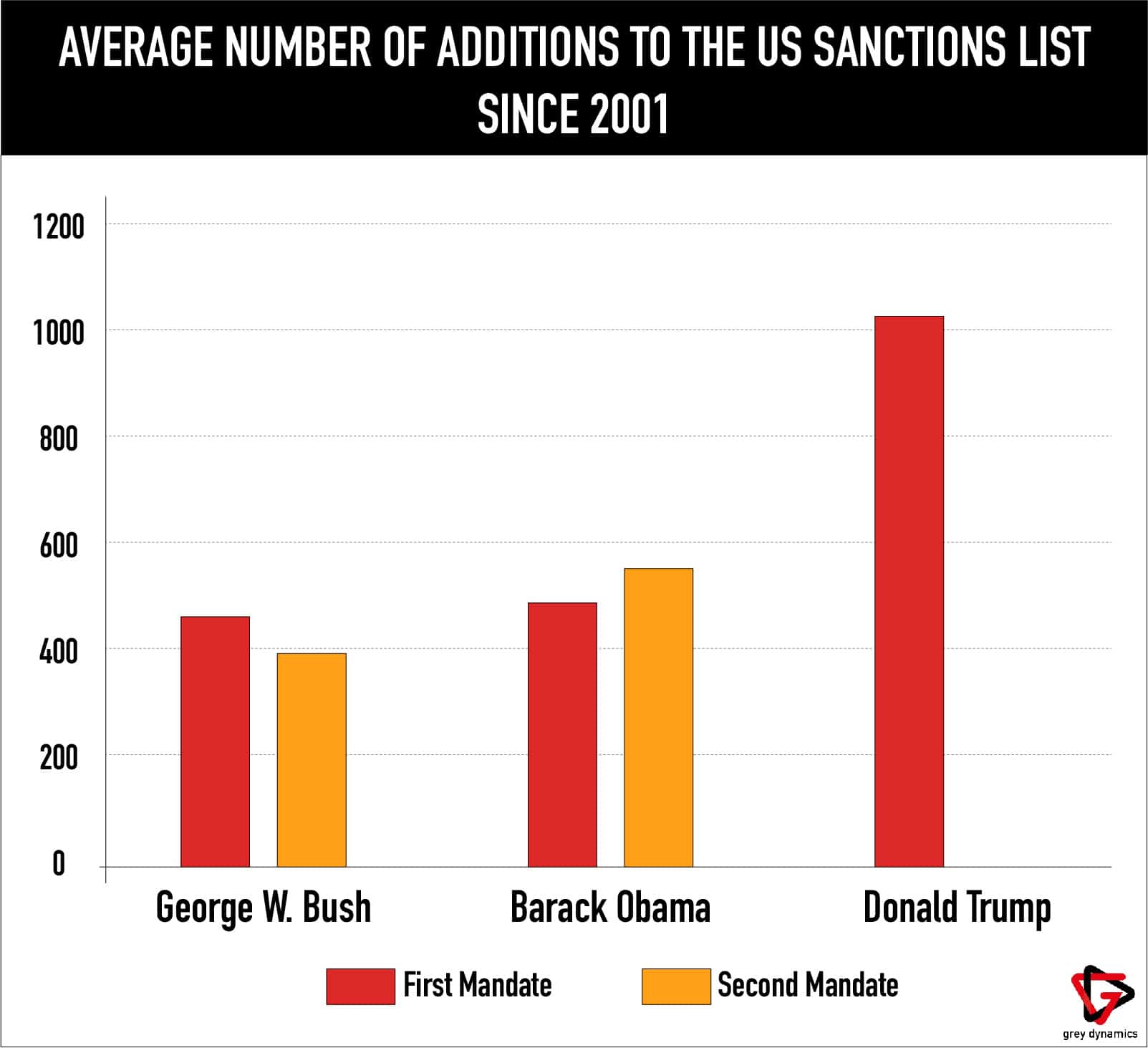
The imposition of US sanctions is an increasingly controversial topic. The Trump administration weaponised sanctions, the number of sanctions doubled compared to the one imposed by the past presidents of the United States, including Barack Obama and George W. Bush. The main target of this new policy is Iran, which is affected by US sanctions since 1979.
Between 2017 and 2021, during Trump’s administration, the average number of annual additions to the US sanctions list was 1,027.5, which cannot be compared to the 533 additions of President Obama and the 435 of President Bush. Until 2017, the record was set by President Obama, which in 2016 added 695 new entities and individuals to the US list. His main priorities were Iran, between 2010 and 2015, and Russia, between 2014 and 2016.
According to Gibson Dunn’s data, Trump established around 3,900 new trade and economic sanctions, setting the record in 2018 with 1,474 new sanctions. 2018 was also characterised by the US withdrawal from the nuclear deal with Iran, signed in 2015.
During Trump’s presidency, the value of the Office of Foreign Assets Control (OFAC) monetary penalties, which is the office that implements the sanctions, was around $1.7B. On the 5th of November 2018, Trump imposed sanctions on a staggering 700 entities and persons, adding 300 new targets to the list.

Main Targets
During these four years of presidency, these weaponised sanctions hit many countries, especially China, Iran, North Korea, Russia and Venezuela.
On the 17th of June 2020, the United States signed the Uyghur Human Rights Policy Act of 2020, which authorizes the enforcement of sanctions on individuals responsible for abuses and human rights violations against Muslim minorities in China or elsewhere. Under this act, the US imposed sanctions on various members of the Chinese government, such as Chen Quango, Xinjiang Communist Party Secretary, and Zhu Hailun, a Communist Party official.
President Trump pursued the economic isolation of North Korea, also sanctioning Russian and Chinese individuals, banks and companies, for supporting the North Korean program on weapons. On a few occasions, the US lifted some of these sanctions in return for promises made by North Korea to freeze its weapons program. These promises were never fulfilled and consequently, the sanctions are still in place.
From 2017, Trump’s administration sanctioned 52 persons and entities from Russia and Ukraine, under the Global Magnitsky Act, which focuses on corruption and the violation of human rights. On the 5th of December 2019, the US additionally enforced sanctions following a bank hacking scheme worth $100 million by a Russian hacker group called Evil Corp.
Venezuela has been affected by US sanctions for over 15 years. Between 2017 and 2021, Trump’s administration imposed more economic sanctions on the government and President Maduro, due to the increasing authoritarianism. The US imposed 166 sanctions on various individuals, the Venezuelan central bank and the state oil company in order to weaken the power of the Venezuelan president.
On the contrary, President Biden stated he will relieve some of these sanctions in exchange for fair national elections in the country.
Last but not least, there is Iran. According to Michael Pompeo, the former US Secretary of State, the US targeted 1500 Iranian entities and individuals during 77 different rounds of sanctions. In September 2019, following the decision to withdraw from the nuclear agreement in May 2018, the US increased the number of targets: firstly, the US started sanctioning whoever was dealing or purchasing Iranian oil.
Secondly, after the alleged Iranian attack on Saudi’s oil facilities, the US targeted various Iranian national banks such as Bank Maskan and Pasargad Bank. According to President Biden, the US will not ease the sanctions related to the nuclear deal until the Iranian government complies with all the regulations stated in the 2015 agreement. Biden’s administration stated that the US would return to the Iranian deal, but it would leave the sanctions that were targeting the Iranian abuses of human rights and its support for terrorist groups. The relationship between Iran and the United States has always been unstable. Both countries want to reach a deal but at the moment none of them wants to take the first step. Further actions will probably be taken after the Iranian presidential elections in June 2021.
What’s Left
Trump’s administration weaponised sanctions as a tool to shape US foreign policy towards these countries. Since the former US administration targeted major international economies, the new one will have to manage the sanctions, without endangering the US economy.
Since its election, President Biden stated that he will not back down from this new policy, even though he will probably recalibrate Trump’s use of the sanctions, choosing which one he will keep or call off.
